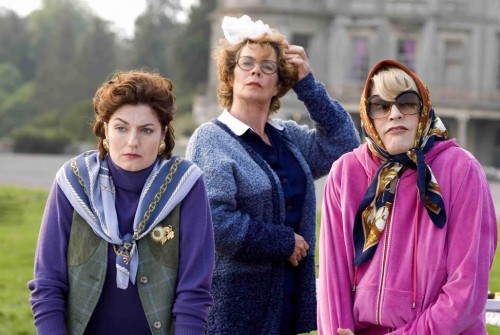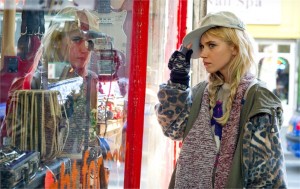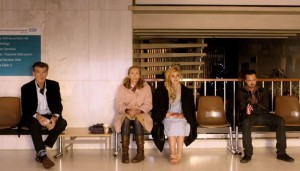This guest post by Bethany Ainsworth-Coles appears as part of our theme week on Female Friendship.
SPOILERS AHEAD
St. Trinian’s is a British comedy legend. In the series of films, a rabble of girls are taught by a selection of oddities and petty criminals, brewing vodka, and doing what they do best. Of course what they do best is illegal, but that’s what these girls are meant to do. In 2007, the films were resurrected with St. Trinian’s, which like so much media directed toward girls, was panned by critics. However, what it is at its heart is girls banding together to save their school with their teachers and winning. It doesn’t matter how they dress, what group they belong to, or their age.
Now the school itself run by the fantastic Miss Camilla Fritton (played by Rupert Everett) and its group of misfit teaching staff includes the big drinker Matron (Celia Imrie) as Camilla’s best friend and confidante. Their friendship is lovely as it is framed not just as two old women best friends. They aren’t the standard old ladies of film past; they are hard drinking, pill-poppers who look after each other, such as turning up to support Camilla when her dog is killed.

The friendships throughout the film defy the general limits that films put on girls’ cinema. The groups (e.g. the emos, posh tottiess, chavs, geeks, etc.) frequently band together. When word gets round that the school needs money, all the girls band together to save it by robbing the national gallery of “Girl with a Pearl Earring.” Isn’t that great? Girls banding together to perform a successful heist with cover, dynamite, and some seriously fantastic dancing is just one of the reasons this film deserves more love. The girls work together–every group from the feral first years to the hippie girl (Juno Temple), and even the school secretary joins in.

Whilst most of the groups already know and tolerate each other, Taylor (a chav as played by Kathryn Drysdale) and Andrea (an emo as played by Paloma Faith–yes that Paloma Faith) become friends through circumstance. Whilst they despise each other since they are from different social circles, when the geeks choose them as the two other girls to actually steal the picture, they slowly become friends. Yes, it’s that trope again, but this time it really works. Their relationship is integral–even though Andrea inadvertently strands the head girl on the other side with the picture–she and Taylor both celebrate when they win. Realistically, they don’t become best friends either but they grow a new tolerance for each other that is certainly an admirable thing to show in a film for girls.
Whilst they work outside their groups, the groups are shown as equally important. Unlike films that actively scathe group systems (e.g. Mean Girls), St. Trinian’s endorses it. This is especially seen with the posh totties’ Chelsea, Chloe, and Peaches (Tamsin Egerton, Antonia Bernath, and Amara Karan). At face value, they seem like spoiled rich girls; however, they are actually bright charming women who simply enjoy their lifestyles and how they look. They win the quiz through Chloe’s intelligence, not through looks. Also they are pretty strong women who take no prisoners, especially dealing with creepy men taking their trousers down in their dorm room. Of course, everyone knows the only way to deal with that is to chuck that nasty piece of work out of the window and into the fountain below.
Now another interesting friendship is between Camilla and the head girl, Kelly (Gemma Arterton). Camilla doesn’t treat her as someone lesser but treats her as an equal and gives her tasks that she knows will be good for Kelly. However when Kelly can’t finish the heist, instead of letting the girl take the fall, she gets out a grappling hook, zips over, and saves her. It’s not seen as a weakness of Kelly’s either; her needing help is a positive. She can rely on Camilla to save her just like she can rely on her school.
Now whilst this seems like an odd collection of friendships, it is an important selection of lessons. It fosters the idea that girls working together will always be better than scheming men, and will always sort things out even if they do need help. Girls are fearless: willing to steal, blow up iron bars, fight back against creeps, and speak out. And most importantly, it’s OK to make mistakes. The girls also enjoy themselves doing it. What’s better than spending an evening repainting their spiv’s car whilst nattering on to their mates? Nothing apart from convincing the general public your school is exceptional. Which it is in a way. The girls enjoy being themselves, modifying their uniforms to match their personalities, and embracing being girls. There are no uniform codes, no rules against makeup, they brew vodka in science, and aren’t frowned upon for that. They may not be the demure schoolgirls people expect, but they sure are the best.
Like all good films for girls, it suffered like all good films for women, and was panned by male critics who didn’t understand why girls could be so fantastic.

The soundtrack for St. Trinian’s even consists of mainly girls. It features everyone from the Noisettes, Lady Sovereign, and Girls Aloud does the theme song. This entire film celebrates female friendships and girls in general. Isn’t that fabulous? It is a film with genuine adventure, laughs that don’t depend on mocking the girls but laughing with them. In fact, all the men are pointless and ripe for being used for their cause. This cast of male characters includes Stephen Fry, the Bursar (Toby Jones), the spiv Flash Harry (Russell Brand), Fritton’s own brother (Everett Still), and Geoffrey Thwaites (Colin Firth), who is Camilla’s vague love interest–and antagonist–who is exposed at the end in more ways than one.
In St. Trinian’s, girls are the most important. Their friendships are valued above anything else because without them their scheming wouldn’t work and then they would be in normal schools… and who wants that?
Bethany Ainsworth-Coles is a young writer from England who enjoys over analyzing things and watching films. She tweets over at https://twitter.com/wierdbuthatsok







